MERCEDES-BENZ E-CLASS CABRIOLET 2010 Service Manual
Manufacturer: MERCEDES-BENZ, Model Year: 2010, Model line: E-CLASS CABRIOLET, Model: MERCEDES-BENZ E-CLASS CABRIOLET 2010Pages: 333, PDF Size: 7.64 MB
Page 41 of 333
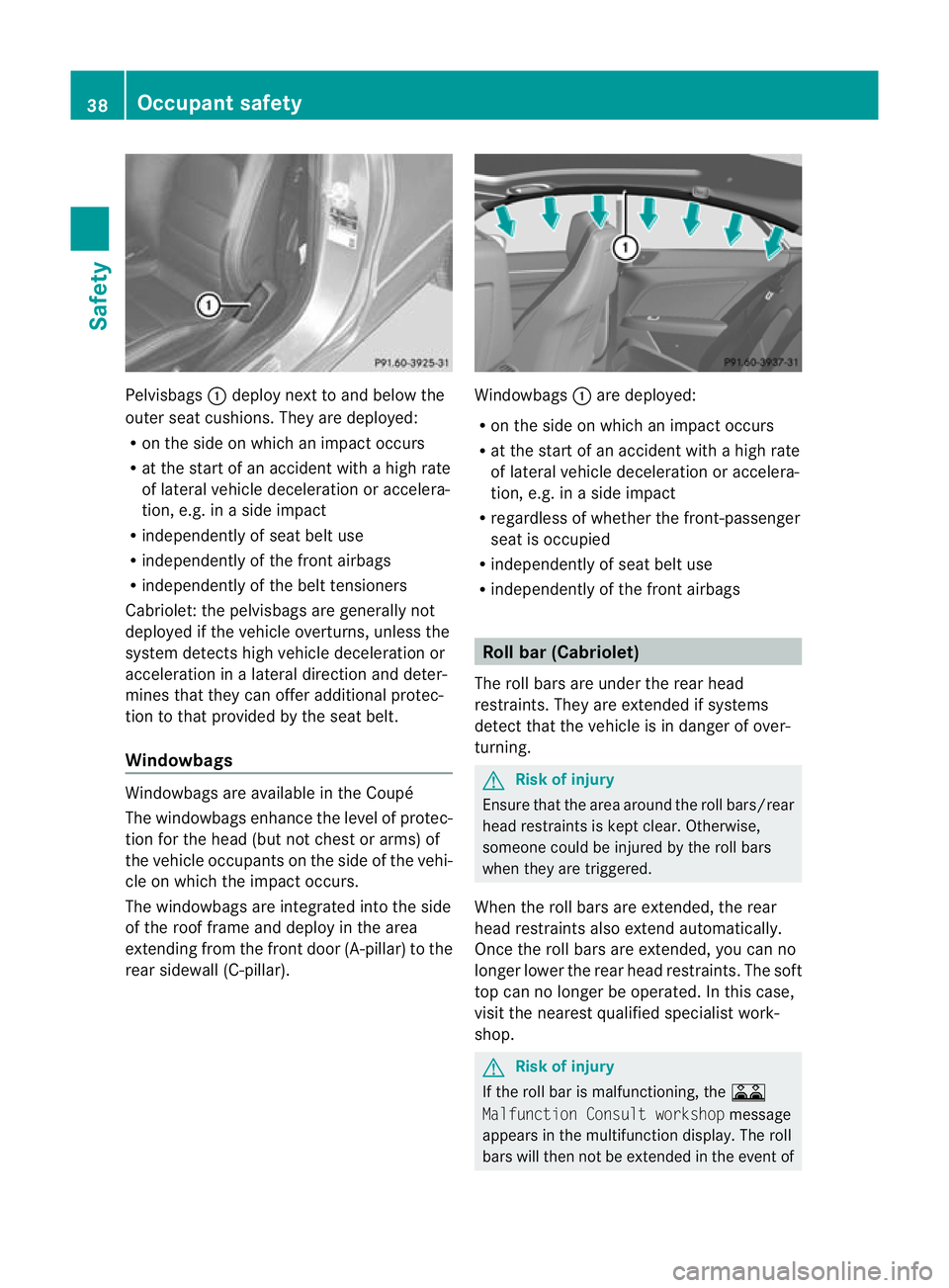
Pelvisbags
:deploy next to and below the
outer seat cushions. They are deployed:
R on the side on which an impact occurs
R at the star tofanaccident with ahigh rate
of lateral vehicle deceleration or accelera-
tion, e.g. in aside impact
R independently of seat belt use
R independently of the fron tairbags
R independen tlyo fthe belt tensioners
Cabriolet :the pelvisbags ar egenerally not
deployed if the vehicle overturns ,unles sthe
system detec tshigh vehicle deceleration or
acceleration in alateral direction and deter-
mines that they can offer additional protec-
tion to that provided by the seat belt.
Windowbags Windowbag
sare availabl eint he Coupé
The windowbags enhance the level of protec-
tion for the head (but not chest or arms) of
the vehicle occupants on the side of the vehi-
cle on whic hthe impac toccurs.
Th ew indowbags are integrated into the side
of the roof frame and deploy in the area
extending from the front door (A-pillar )tothe
rea rsidewall (C-pillar). Windowbags
:are deployed:
R on the side on which an impact occurs
R at the start of an accident with ahigh rate
of lateral vehicle deceleration or accelera-
tion, e.g. in aside impact
R regardless of whether the front-passenger
seat is occupied
R independently of seat belt use
R independently of the front airbags Roll bar (Cabriolet)
The roll bars are under the rear head
restrain ts.T hey ar eextended if systems
detect that the vehicl eisindanger of over-
turning. G
Risk of injury
Ensure that the area around the roll bars/rear
head restraint siskept clear .Otherwise,
someone could be injured by the roll bars
when they are triggered.
Whe nthe rol lbars are extended, the rear
head restraint salso exten dautomatically.
Once the roll bars are extended, you can no
longer lower the rear head restraints. The soft
top can no longer be operated. In this case,
visit the nearest qualified specialist work-
shop. G
Risk of injury
If the roll bar is malfunctioning, the A
Malfunctio nConsult workshop message
appears in th emultifunction display .The roll
bar sw ill then not be extended in the event of 38
Occupant safetySafety
BA 207 ECE ÄJ 2010/1a; 1; 2, en-GB
mkalafa
Version: 3.0.2.11 2010-01-26T13:03:22+01:00-Seite 38
Page 42 of 333

an accident. This could result in sever
eor
even fatal injuries to you and other occupants.
In this case, visi taqualifieds pecialist work-
shop immediately and have the roll bar
checked. PRE-SAFE
®
system
PRE-SAFE ®
take spre-e mptive measures to
protect you in certain hazardous situations.
PRE-SAFE ®
intervenes:
R in emergency braking situations, e.g. if the
BA SB rake Assist System is activate dorthe
BA SP LUS Brak eAssist System intervenes
powerfully
R if the radar sensor system detects an immi-
nen tdanger of collision in certain situa-
tion s(on vehicles with DI STRONIC PLUS)
R in critical situatio nsinvolvin gdriving
dynamics, e.g .ifthe vehicle oversteers or
understeers significantly due to physical
limits being exceeded or if the vehicle
swerves to avoid an obstacle at aspeed of
over 14 0km/h.
PRE-SAFE ®
takes th efollowin gmeasures
dependin gonthe hazardou ssituation detec-
ted:
R the fron tseat belts are pre- tensio ned.
R vehicles with memory fun ctions: under
acciden tconditions, it adjusts the front-
passenger seat if it is in an unfavourable
position.
R vehicles with amulticontour seat: the air
pressure in the seat side cushions and in
the backrest side bolsters is increased.
R if the vehicle skids ,the fron tside windows
and, on the Coupé, the panorama sliding
sunroof, are closed so that only asmall gap
remains.
If th ehazardous situation passe swithout
resulting in an accident ,PRE-SAFE ®
slackens
the belt pretensioning. The air pressure in the
side bols terson the multicontour seat is redu
ceda gain. All settings made by PRE-
SAFE ®
can the nbereversed.
If the seat belts are not released:
X Move the backrest or the seat back slightly
until the belt pretensionin gisreduced.
The locking mechanism releases. G
Warning
Make sure that nobody can becom etrapped
as yo uadjust the seat.
! Make sure that there are no objects in the
footwell or behind the seats when moving
the seat back. There is arisk that the seats
and/or the objects could be damaged.
More information abou tbelt adjust ment,a
convenience function integrate dinto PRE-
SAFE ®
,c an be found in the "Belt adjustment"
section (Y page 42). NECK-PRO head restraints
The NECK -PRO head restraints increase pro-
tection to the driver's and front-passenger's
head and neck .Tot his end, the head
restraint sonthe driver's and front-passenger
seats ar emoved forwards and upwards in the
even tofa rear-end collision of acertain
severity. This provides better head support. G
Risk of inju
ry
Head restraint cove rsprevent the NECK-PRO
head restraint sfrom triggering correctly .Con-
sequently, the NECK-PRO head restraints
cannot provide the intended level of protec-
tion .Don ot use head restraint covers.
If the NECK-PRO head restraints have been
triggered in an accident, you must reset the
NECK-PRO head restraints on the driver’s and
front-passenger seat (Y page 40). Other-
wise, the additional protection will not be
available in the even tofanother rear-end col-
lis ion. You can recognise whe nNECK-PRO
head restraints have bee ntriggere dbythe
fact that they hav emoved forwards and can
no longer be adjusted. Occupant safety
39Safety
BA 207ECE ÄJ 2010/1a; 1; 2, en-GB
mkalafa Version: 3.0.2.11 2010-01-26T13:03:22+01:00-Seite 39 Z
Page 43 of 333
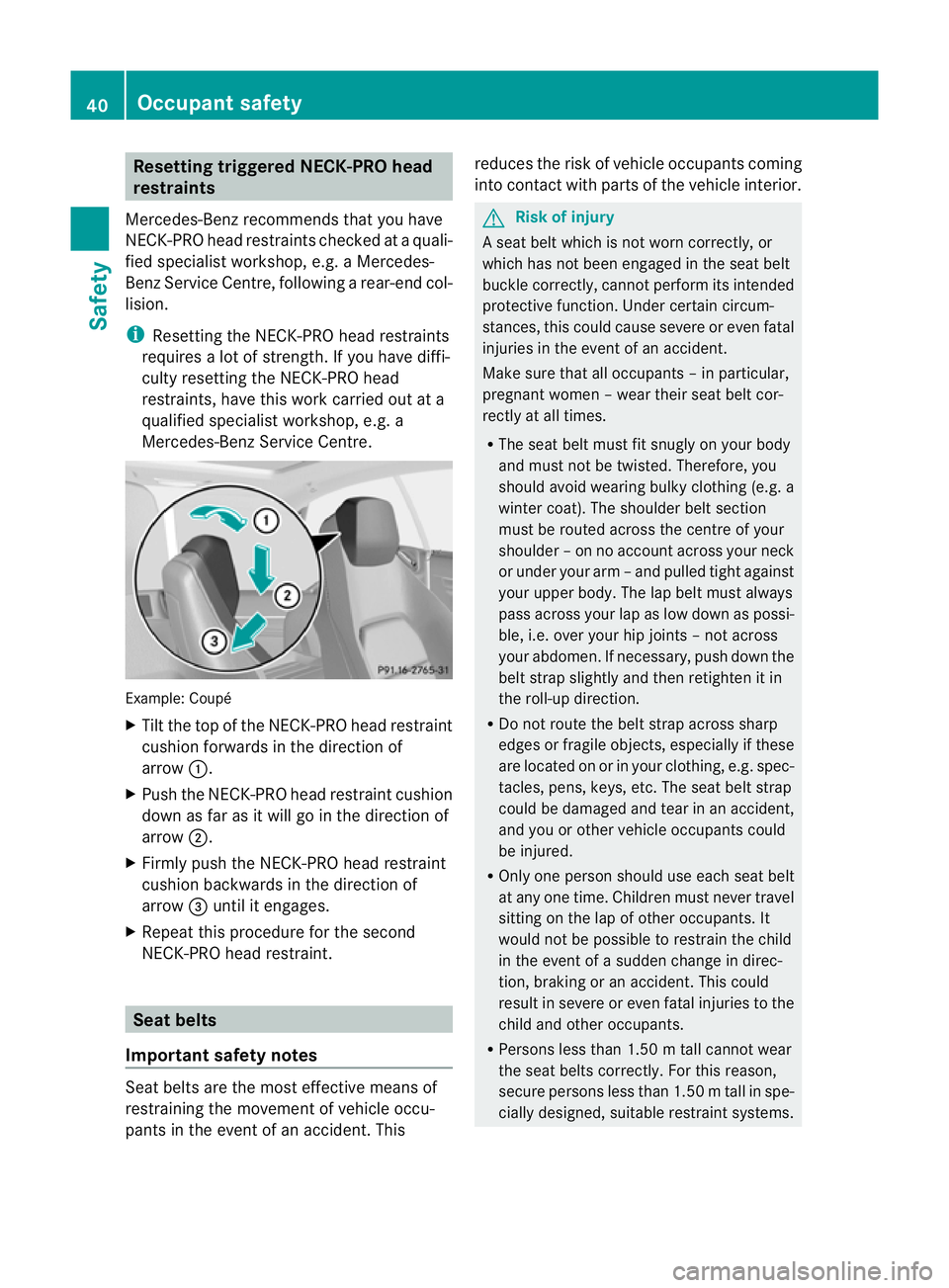
Resetting trig
geredN ECK-PR Ohead
restraints
Mercedes-Ben zrecom mends that you have
NECK-PRO hea drestraint schecked at aquali-
fied specialist workshop, e.g. aMercedes-
Ben zService Cent re,followin garear-en dcol-
lision.
i Resetting the NECK -PRO head restraints
requires alot of strength. If you have diffi-
culty resettin gthe NECK -PRO head
restraints, have this work carried out at a
qualified specialist workshop, e.g. a
Mercedes-Benz Service Centre. Example: Coupé
X
Tilt the top of the NECK-PRO head restraint
cushio nforwards in the direction of
arrow :.
X Push the NECK -PRO head restraint cushion
down as far as it will go in the direction of
arrow ;.
X Firmly push the NECK-PRO head restraint
cushio nbackwards in the direction of
arrow =until it engages.
X Repeat this procedure for the second
NECK -PRO head restraint. Seat belts
Important safet ynotes Seat belts are the most effective means of
restrainin gthe movemen tofvehicle occu-
pant sint he even tofanaccide nt.T his reduce
sthe risk of vehicle occupants coming
int oc ontac twith parts of the vehicle interior. G
Risk of injury
As eat belt which is not worn cor rectly, or
which has not bee nengaged in the sea tbelt
buckle cor rectly, cannot perform its intended
prote ctive function .Under certain circum-
stances, this could cause severe or even fatal
injuries in the event of an accident.
Make sure that all occupants –inparticular,
pregnan twome n–w ear their seat belt cor-
rectly at all times.
R The seat belt must fit snugly on your body
and must no tbetwisted. Therefore, you
should avoid wearing bulky clothin g(e.g. a
winter coat) .The shoulder belt section
must be routed across the cen treofy our
shoulder –onnoaccount acros syour neck
or under your arm –and pulled tight against
your uppe rbody. The lap belt must always
pass across your lap as low down as possi-
ble, i.e. over your hip join ts–n ot across
your abdomen. If necessary ,push down the
belt strap slightly and then retighten it in
the roll-up direction.
R Do not route the belt strap across sharp
edge sorfragil eobjects, especially if these
are located on or in your clothing, e.g. spec-
tacles, pens, keys, etc. The seat belt strap
could be damaged and tear in an accident,
and you or other vehicl eoccupants could
be injured.
R Onl yone person should use each sea tbelt
at any one time. Children must never travel
sittin gont he lap of other occupan ts.It
would not be possible to restrain the child
in the event of asudden change in direc-
tion, braking or an accident .This could
result in sever eoreven fata linjuries to the
child and othe roccupants.
R Persons les sthan 1.50 mtall cannot wear
the seat belts correctly. For this reason,
secure persons less than 1.50 mtall in spe-
cially designed, suitable restraint systems. 40
Occupant safetySafety
BA 20
7ECE ÄJ 2010/1a; 1; 2, en-GB
mkalafa Version: 3.0.2.11 2010-01-26T13:03:22+01:00-Seite 40
Page 44 of 333
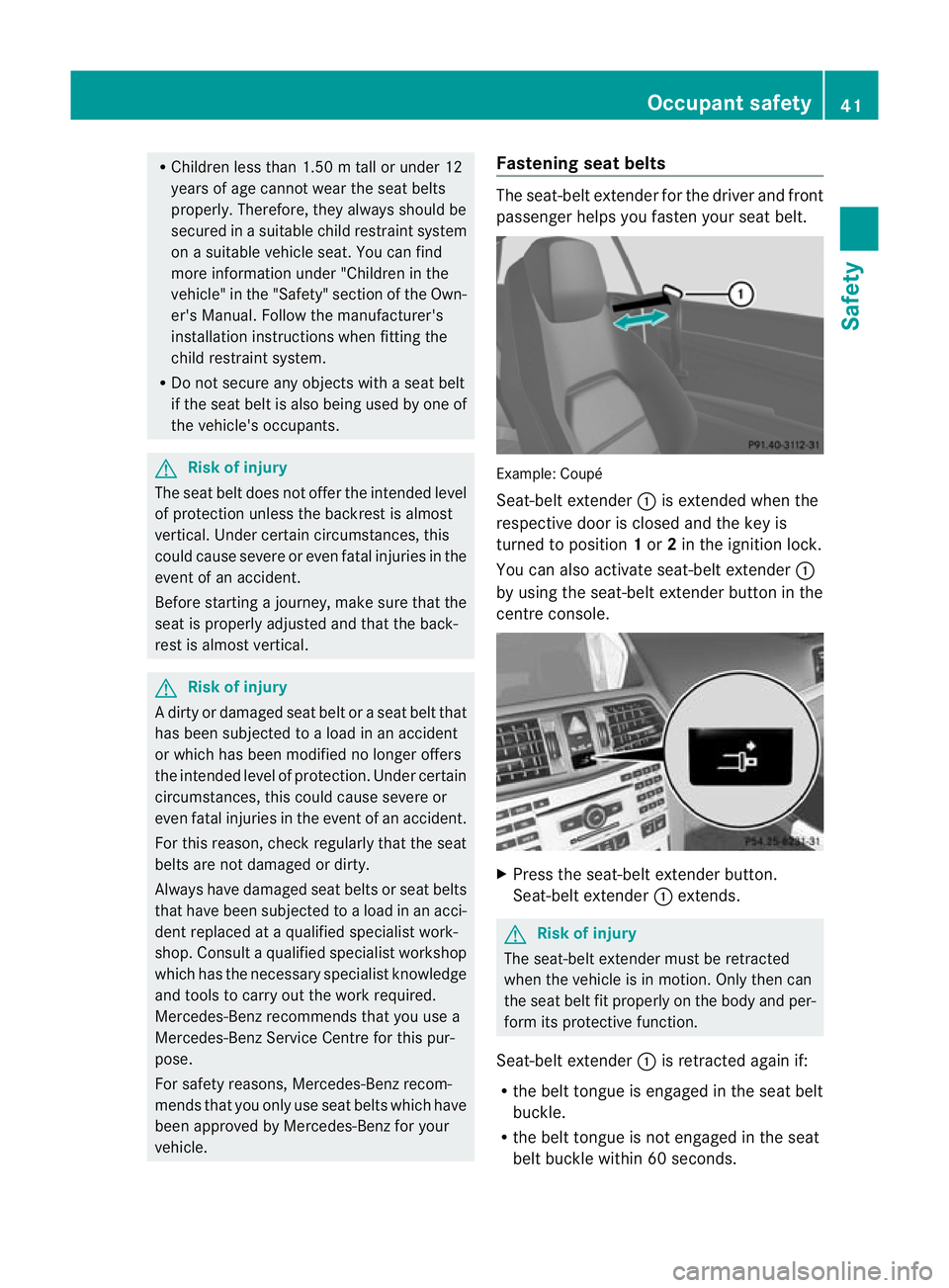
R
Children less than 1.50 mtall or under 12
years of age cannot wear the seat belts
properly. Therefore, they always should be
secured in asuitable child restraint system
on asuitable vehicle seat. You can find
more information under "Children in the
vehicle" in the "Safety" section of the Own-
er's Manual. Follow the manufac turer's
installatio ninstructions whe nfitting the
child restraint system.
R Do not secure any objects with aseat belt
if the seat belt is also being used by one of
the vehicle's occupants. G
Risk of injury
The seat belt does not offer the intended level
of protection unless the back rest is almost
ver tical. Under certain circumstances, this
coul dcause severe or even fatal injuries in the
event of an accident.
Befor estarting ajourney, mak esure that the
seat is properly adjusted and that the back-
rest is almost vertical. G
Risk of injury
Ad irtyo rdamaged seat belt or aseat belt that
has been subjected to aload in an accident
or which has been modified no longer offers
the intended level of protection. Un dercertain
cir cumstances, this could caus esever eor
even fatal injuries in the even tofanaccident.
For thi sreason, check regularly that the seat
belts are not damaged or dirty.
Alway shaved am aged sea tbelts or seat belts
that have been subjected to aload in an acci-
dent replaced at aqualified specialist work-
shop. Consult aqualified specialist workshop
which has the necessary specialist knowledge
and tools to carry out the work required.
Mercedes -Benz recommends that you use a
Mercedes-Benz Ser vice Centre for thi spur-
pose.
For safety reasons, Mercedes -Benz recom-
mends that you only use seat belts which have
been approved by Mercedes-Benz for your
vehicle. Fastening seat belts The seat-belt extender for the driver and front
passenger helps you fasten your seat belt.
Example: Coupé
Seat-belt extender
:is extended when the
respective door is closed and the key is
tur nedtop osition 1or 2in the ignition lock.
You can also activa teseat -belt extender :
by using the seat-belt extender button in the
centre console. X
Press the seat-belt extender button.
Seat -belt extender :extends. G
Risk of inju
ry
The seat-belt extender must be ret racted
whe nthe vehicle is in motion .Only then can
the sea tbelt fit properly on the body and per-
for mi ts protective function.
Seat-belt extender :is retracted again if:
R the belt tongue is engaged in the sea tbelt
buckle.
R the belt tongue is not engaged in the seat
belt buckle within 60 seconds. Occupant safety
41Safety
BA 207ECE ÄJ 2010/1a; 1; 2, en-GB
mkalafa Version: 3.0.2.11 2010-01-26T13:03:22+01:00-Seite 41 Z
Page 45 of 333
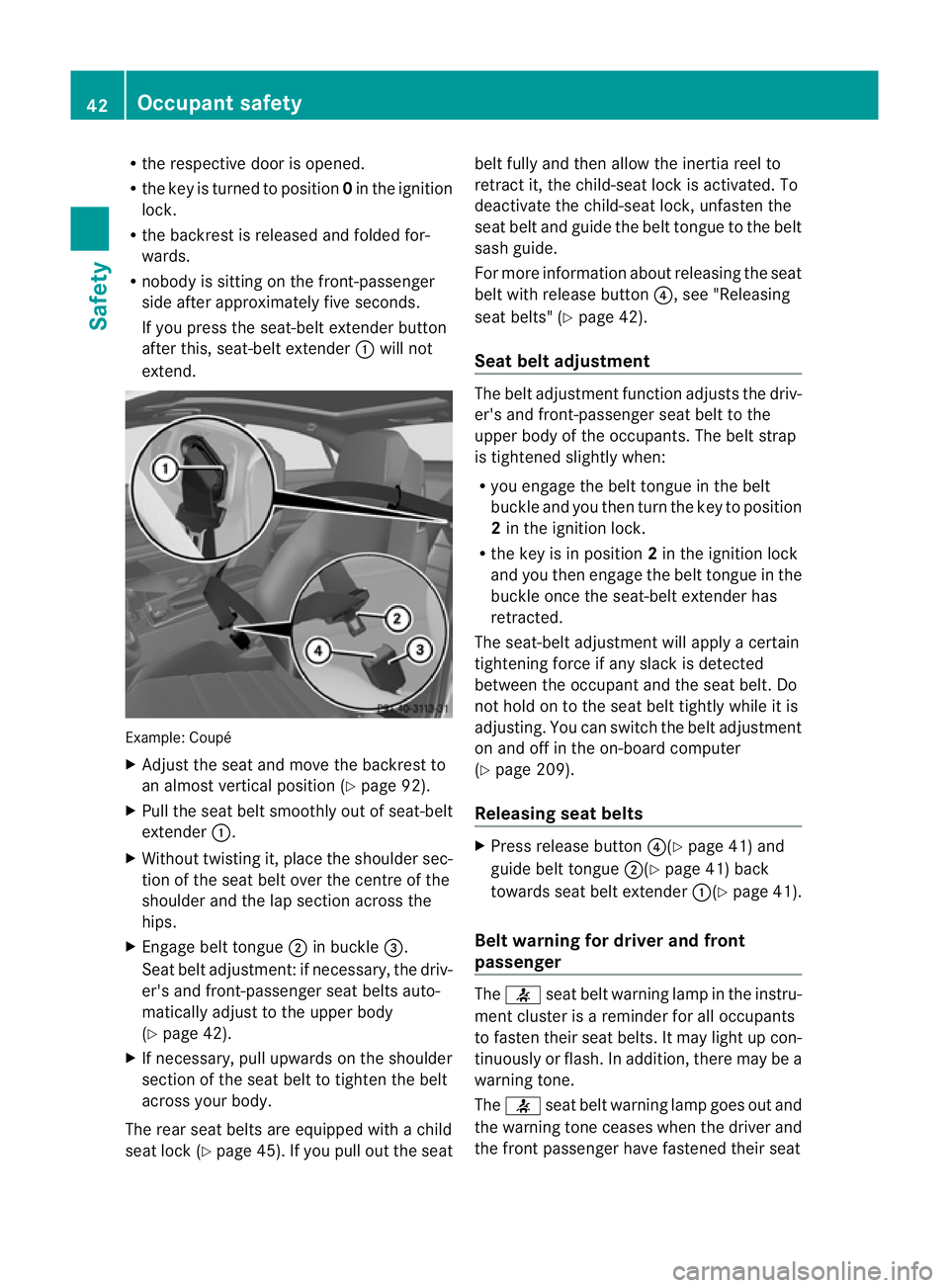
R
the respective door is opened.
R the key is turne dtoposition0in the ignition
lock.
R the backr estis release dand folde dfor-
wards.
R nobod yissitting on the front-p assenger
side after approximat elyf ives econds.
If yo upress th eseat-bel textender button
afte rthis, seat-belt extender :will not
extend. Example: Coupé
X
Adjust the seat and mov ethe backrest to
an almost vertical position (Y page 92).
X Pull the seat belt smoothly out of seat-belt
extender :.
X Withou ttwisting it, place the shoulde rsec-
tion of the seat belt over the centre of the
shoulder and the lap section across the
hips.
X Engage belt tongue ;in buckle =.
Seat belt adjustmen t:if necessary, the driv-
er' sa nd front-passenger sea tbelts auto-
maticall yadjust to the upper body
(Y page 42).
X If necessary, pull upwards on the shoulder
section of the seat belt to tighten the belt
across your body.
The rear seat belts are equipped with achild
seat lock (Y page 45). If you pull out the seat belt fully and then allow the iner
tiar eel to
ret ract it, the child-seat lock is activated. To
deactivate the child-seat lock ,unfasten the
sea tbelt and guide the belt tongue to the belt
sash guide.
For mor einformation about releasing the seat
bel tw ith release button ?,see "Releasing
seat belts" (Y page 42).
Seat belt ad justment The belt adjustment function adjusts the driv-
er' sa nd front-passenger sea tbelt to the
upper body of the occupants. The belt strap
is tightened slightly when:
R you engage the belt tongue in the belt
buckle and you then tur nthe key to position
2 in the ignition lock.
R the key is in position 2in the ignition lock
and you then engage the belt tongue in the
buckle onc ethe seat-belt extender has
ret racted.
Th es eat-belt adjust ment will appl yacertain
tightening for ceif any slack is detected
between the occupan tand the sea tbelt. Do
not hold on to the seat belt tightly while it is
adjusting. You can switc hthe belt adjustment
on and off in the on-boar dcompu ter
( Y page 20 9).
Releasin gseat belts X
Press release button ?(Ypage 41) and
guide belt tongue ;(Ypage 41) back
towards seat belt extender :(Ypage 41).
Belt warning for driver and front
passenger The
7 seat belt warnin glamp in the instru-
ment cluster is areminder for all occupants
to fasten their seat belts. It may light up con-
tinuously or flash. In addition ,ther em ay be a
warning tone.
The 7 seat belt warning lamp goes out and
the warning ton eceases when the driver and
the fron tpassenger have fastened their seat 42
Occupant safetySafety
BA 20
7ECE ÄJ 2010/1a; 1; 2, en-GB
mkalafa Version:3.0.2.11
2010-01-26T13:03:22+01:00
-Seite 42
Page 46 of 333
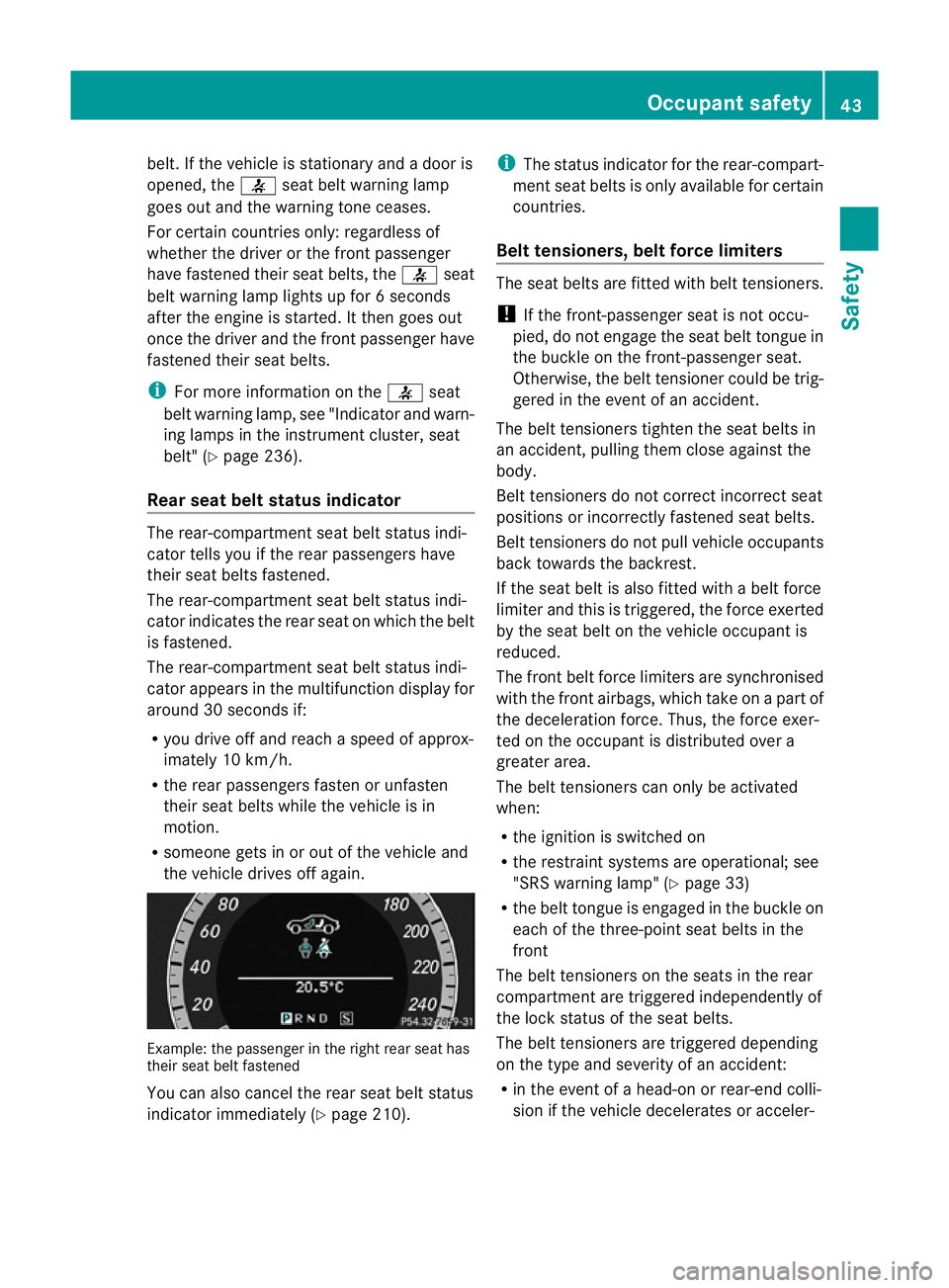
belt. If the vehicle is stationar
yand adoor is
opened, the 7seat belt warnin glamp
goes out and the warning ton eceases.
For cer tain countries only: regardless of
whether the driver or the fron tpassenger
have fastened their seat belts, the 7seat
belt warning lamp lights up for 6seconds
after the engin eisstarted. It then goe sout
onc ethe driver and the fron tpassenger have
fastened their seat belts.
i For mor einformation on the 7seat
bel twarning lamp, see "Indicator and warn-
in gl am ps in the instrument cluster ,seat
belt" (Y page 236).
Rear seat belt status indicator The rear-compartment sea
tbelt status indi-
cator tells you if the rear passengers have
their seat belts fastened.
The rear-compartment seat belt status indi-
cator indicates the rear seat on which the belt
is fastened.
The rear-compartment seat belt status indi-
cator appear sint he multifunction displa yfor
around 30 seconds if:
R you drive off and reach aspeed of approx-
imately 10 km/h.
R the rear passengers fasten or unfasten
their seat belts while the vehicle is in
motion.
R someon egets in or out of the vehicle and
the vehicle drives off again. Example: the passenger in the right rea
rseat has
their seat belt fastened
You can also cancel the rear seat belt status
indicator immediately (Y page 210). i
The status indicator for the rear- compart-
ment seat belts is only available for certain
countries.
Bel ttensioners, belt force limiters The seat belts are fitted with belt tensioners.
!
If the front-passenger seat is not occu-
pied, do not engage the seat belt tongue in
the buckle on the front-passenger seat.
Otherwise, the belt tensioner could be trig-
gered in the event of an accident.
The belt tensioners tighten the seat belts in
an accident, pulling them close against the
body.
Belt tensioners do not correct incorrect seat
positions or incorrectly fastened seat belts.
Belt tensioners do not pull vehicle occupants
back towards the backrest.
If the seat belt is also fitted with abelt for ce
limiter and this is triggered, the forc eexerted
by the sea tbelt on the vehicle occupan tis
red uced.
Th ef ront be ltforce limiter sare synchronised
wit hthe front airbags, whic htake on apart of
the deceleration force. Thus, the force exer-
ted on the occupant is distributed over a
greater area.
The belt tensioners can only be activated
when:
R the ignition is switched on
R the restraint systems are operational; see
"SRS warning lamp" (Y page 33)
R the belt tongue is engaged in the buckle on
each of the three-point seat belts in the
front
The belt tensioners on the seats in the rear
compartment are triggered independently of
the lock status of the seat belts.
The belt tensioners are triggered depending
on the type and severity of an accident:
R in the event of ahead-on or rear-end colli-
sion if the vehicle decelerates or acceler- Occupant safety
43Safety
BA 207ECE ÄJ 2010 /1a; 1; 2, en-GB
mkalafa Version: 3.0.2.11 2010-01-26T13:03:22+01:00 -Seite 43 Z
Page 47 of 333
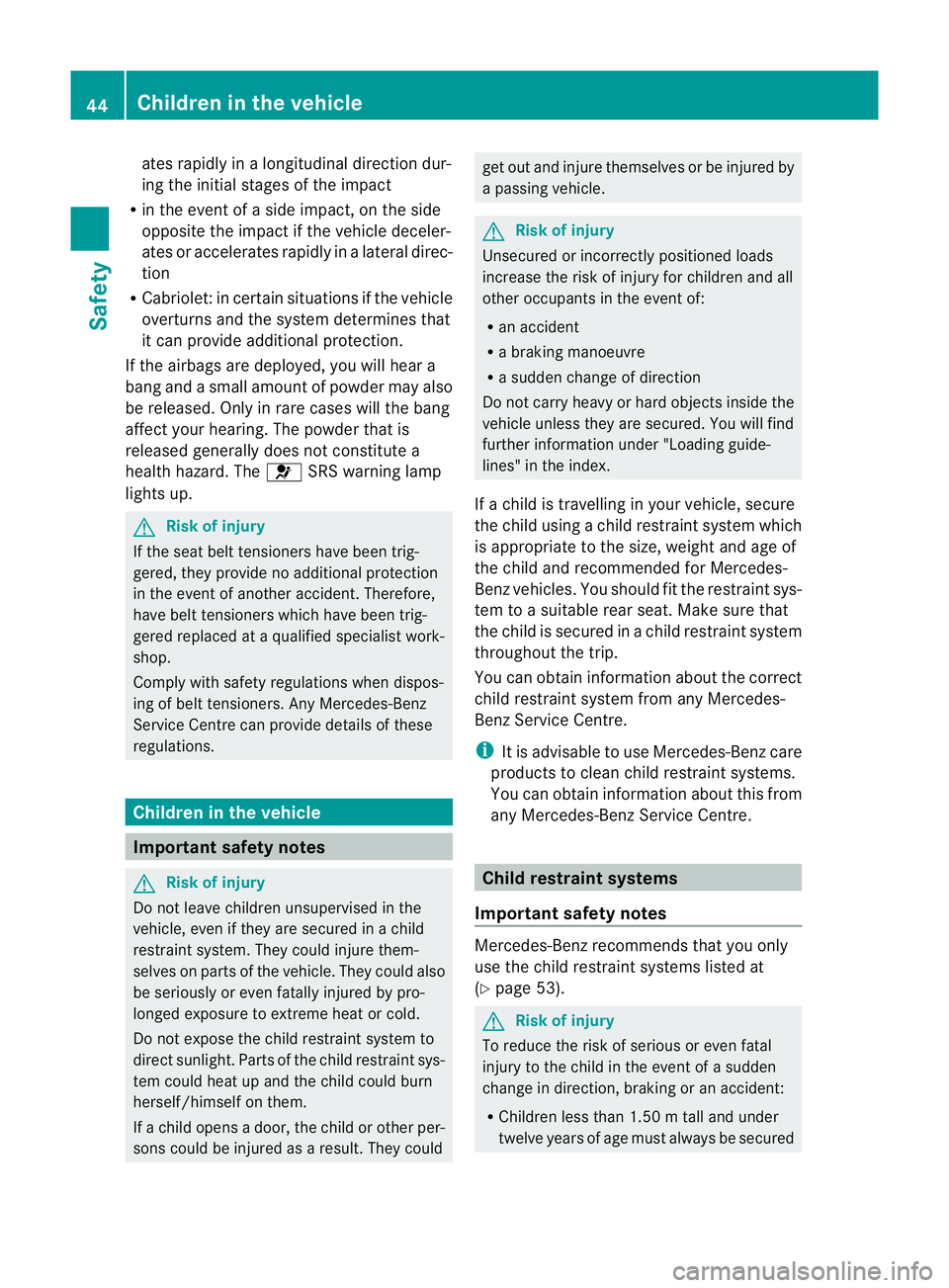
ates rapidly in
alongitudinal dir ectiondur-
ing the initial stages of the impact
R in the even tofaside impact, on th eside
opposit ethe im pactift he vehicle deceler-
ates or accelerates rapidly in alateral direc-
tion
R Cabriolet: in certain situations if the vehicle
overturns and the system determines that
it can provide additional protection.
If the airbags are deplo yed,you will hear a
bang and asmall amount of powder may also
be released. Only in rare cases will th ebang
affect your hearing. The powde rthat is
released generally does not constitute a
healt hhazard. The 6SRS warning lamp
lights up. G
Risk of injury
If the seat belt tensioners have been trig-
gered, they provide no additional protection
in the event of another accident. Therefore,
have belt tensioners which have been trig-
gered replaced at aqualified specialist work-
shop.
Comply with safety regulations when dispos-
ing of belt tensione rs.A ny Mercedes-Be nz
Service Centre can provid edetails of these
regulations. Children in the vehicle
Impor
tantsafety notes G
Ris
kofi njury
Do not leav echildren unsupervised in the
vehicle, even if they ar esecured in achild
restraint system .They coul dinjure them-
selves on parts of the vehicle. The ycould also
be seriously or even fatally injure dbypro-
longe dexposure to extreme hea torcold.
Do not expose the child restraint system to
direct sunlight. Part softhe chil drestraint sys-
tem could heat up and the child could burn
herself/himself on them.
If ac hild opens adoor, the child or other per-
sons coul dbeinjured as aresult. They could get out and injure themselves or be injured by
ap
assing vehicle. G
Risk of injury
Unsecured or incorrectly positioned loads
increase the risk of injury for children and all
other occupants in the event of:
R an accident
R ab raking manoeuvre
R as udden change of direction
Do not carry heavy or hard objects inside the
vehicle unless they are secured. You will find
further information under "Loading guide-
lines" in the index.
If ac hild is travellin ginyour vehicle, secure
the child using achild restraint system which
is appropriate to the size, weight and age of
the chil dand recommended for Mercedes-
Benz vehicles. You should fit the restraint sys-
tem to asuitable rear seat. Make sure that
the child is secured in achild restraint system
throughout the trip.
You can obtai ninformation abou tthe correct
chil drestraint system from any Mercedes-
Benz Servic eCentre.
i It is advisable to use Mercedes-Ben zcare
product stocleanc hildr estraint systems.
You can obtain informatio nabout this from
any Mercedes-Benz Ser vice Centre. Chil
drestraint systems
Importan tsafety notes Mercedes-Benz reco
mmends that you only
use the child restraint system slisted at
(Y page 53). G
Risk of injury
To reduce the risk of serious or even fatal
injury to the child in the event of asudden
change in direction, brakin goranaccident:
R Children less than 1.5 0mtall and under
twelv eyears of age must alway sbesecured 44
Children in th
evehicleSafety
BA 20 7ECE ÄJ 2010/1a; 1; 2, en-GB
mkalafa Version: 3.0.2.11 2010-01-26T13:03:22+01:00-Seite 44
Page 48 of 333
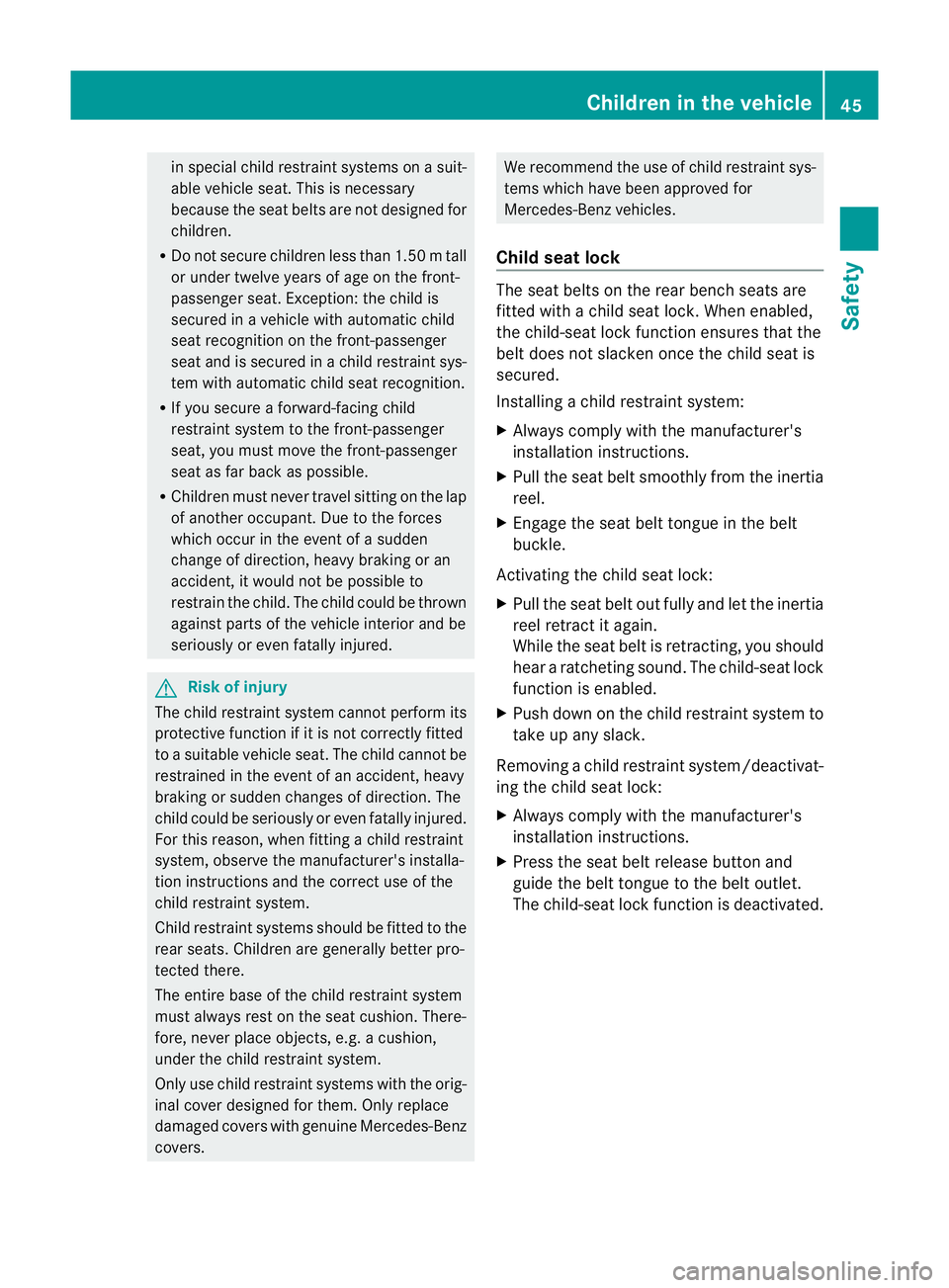
in specia
lchild restraint systems on asuit-
able vehicle seat. This is necessary
because the seat belts are not desig nedfor
children.
R Do not secur echildren less than 1.50 mtall
or under twelv eyears of age on th efront-
passenger seat .Exception: the child is
secured in avehicle with automatic child
sea trecognition on the front-passenger
seat and is secured in achild restraint sys-
tem with automatic chil dseat recognition.
R If you secur eaforward-facing child
restraint system to the front-passenger
seat, you must mov ethe front-passenger
seat as fa rback as possible.
R Children must never travel sitting on the lap
of another occupant. Due to the forces
which occur in the event of asudden
change of direction, heavy braking or an
accident, it would not be possible to
restrain the child. The child could be thrown
against parts of the vehicle interior and be
seriously or even fatally injured. G
Risk of injury
The child restraint system cannot perform its
protective function if it is not correctly fitted
to as uitable vehicle seat. The child cannot be
restrained in the event of an accident, heavy
braking or sudde nchanges of direction. The
chil dcould be seriously or even fatally injured.
For this reason, when fittin gachild restraint
system ,observ ethe manufacturer' sinstalla-
tion instructions and the correct use of the
child restraint system.
Chil drestraint systems should be fitted to the
rear seats. Children are generally better pro-
tected there.
The entir ebase of the child restraint system
must always rest on the seat cushion. There-
fore, never place objects, e.g. acushion,
under the child restraint system.
Only use child restraint systems with the orig-
inal cover designed for them. Only replace
damaged covers with genuine Mercedes-Benz
covers. We recommen
dthe use of chil drestraint sys-
tems which have been approved for
Mercedes-Ben zvehicles.
Child seat lock The seat belts on the rear bench seats are
fitted with
achild seat lock .When enabled,
the child-sea tlock function ensures that the
belt does not slacken onc ethe chil dseat is
secured.
Installing achild restraint system:
X Always comply with the manufacturer's
installation instructions.
X Pull the seat belt smoothly from the inertia
reel.
X Engage the seat belt tongue in the belt
buckle.
Ac tivating th echild seat lock:
X Pull the seat belt out fully and let the inertia
reel retract it again.
While the seat belt is retracting, you should
hear aratcheting sound. The child-seat lock
function is enabled.
X Push down on the child restraint system to
take up any slack.
Removing achild restraint system/deactivat-
ing the chil dseat lock:
X Alway scompl ywith the manufacturer's
installation instruc tions.
X Press the seat belt release button and
guide the belt tongu etothe belt outlet.
The child-sea tlock func tion is deactivated. Children in th
evehicle
45Safety
BA 207ECE ÄJ 2010 /1a;1;2,e n-GB
mkalafa Version: 3.0.2.11 2010-01-26T13:03:22+01:00-Seite 45 Z
Page 49 of 333
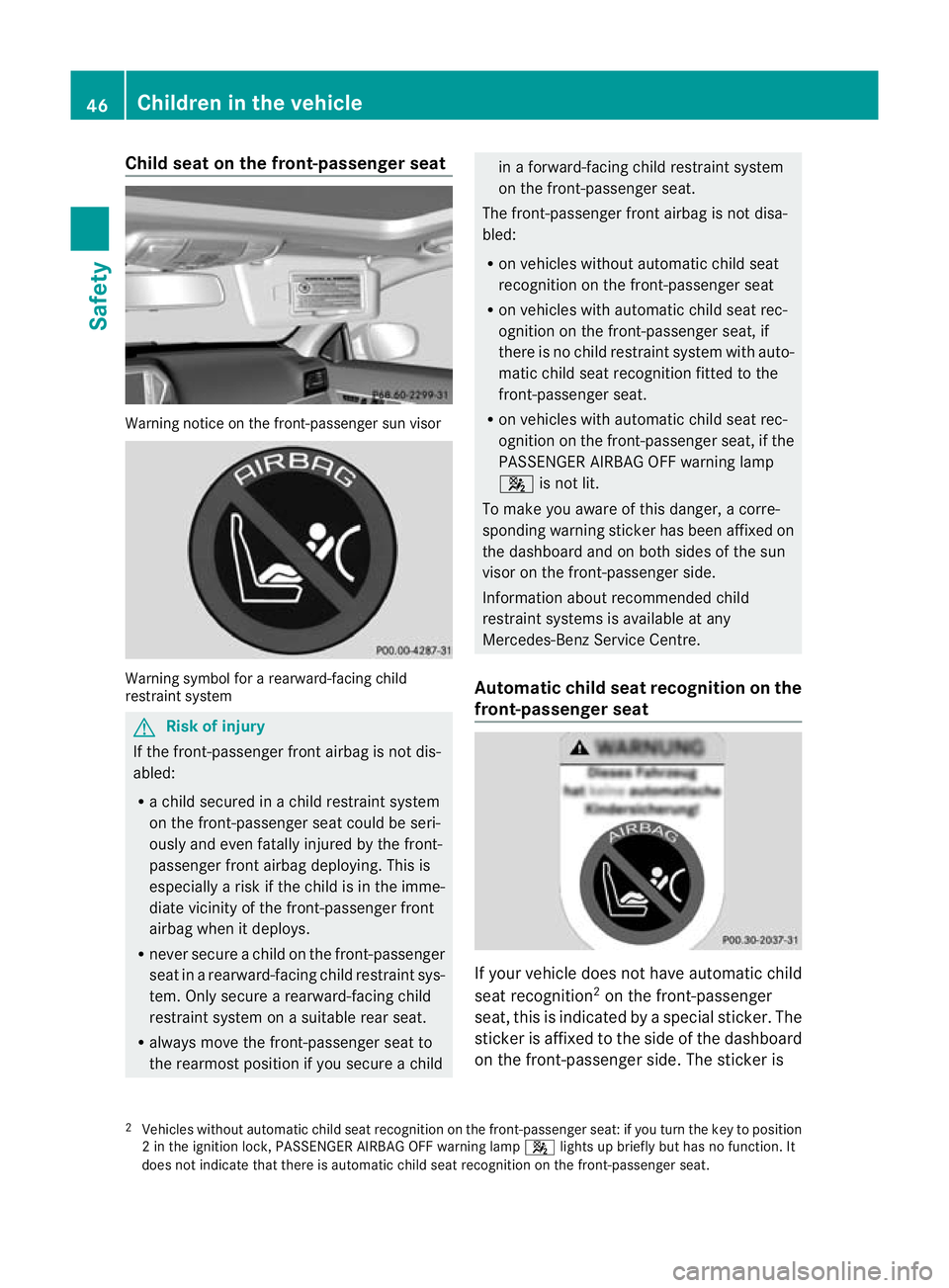
Child seat on th
efront-passenger seat War
ning notic eonthe front-pa ssenger sun visor War
ning symbol for arearward-facing child
restraint system G
Ris
kofi njury
If th efront-p assenger front airbag is not dis-
abled:
R ac hilds ecured in achildr estraint system
on th efront-p assenger seat could be seri-
ously and even fatally injured by the front-
passenger front airbag deploying .This is
especially arisk if the child is in the imme-
diate vicinity of the fron t-passenger front
airba gwhen it deploys.
R never secur eachild on the front-passenger
seat in arearward-facing child restraint sys-
tem. Only secur earearward-facing child
restraint system on asuitable rear seat.
R always move the front-passenger seat to
the rearmost position if you secure achild in
af orward-facing child restraint system
on the front-passenger seat.
The front-passenger front airbag is not disa-
bled:
R on vehicles withou tautomatic child seat
recognition on the front-passenger seat
R on vehicles with automatic child seat rec-
ognition on the front-passenger seat, if
there is no child restraint system with auto-
matic child seat recognition fitted to the
front-passenger seat.
R on vehicles with automatic child seat rec-
ognition on the front-passenger seat, if the
PASSENGER AIRBAG OFF warning lamp
4 is not lit.
To make you aware of this danger, acorre-
spondin gwarning sticker has been affixed on
the dashboard and on both sides of the sun
visor on the front-passenger side.
Infor mation about recommended child
restraint systems is available at any
Mercedes-Benz Service Centre.
Automatic child seat recognitio nonthe
front-passenge rseat If your vehicle does not have automatic child
seat recognition
2
on the fron t-passenger
seat, this is indicated by aspecial sticker. The
sticker is affixed to the side of the dashboard
on the front-passenger side. The sticker is
2 Vehicles withou tautomatic child seat recognition on the front-passenger seat: if you turn the key to position
2int he ignition lock ,PASSENGER AIRBAG OFF warning lamp 4lights up briefly but has no function. It
doe snot indicat ethat ther eisa utomatic child seat recognition on the front-passenger seat. 46
Children in th
evehicleSafety
BA 20 7ECE ÄJ 2010/1a; 1; 2, en-GB
mkalafa Version:3.0.2.11
2010-01-26T13:03:22+01:00
-Seite 46
Page 50 of 333

vis
iblew hen you open the front-passenger
door. The automatic chil
dseat recognition sensor
syste mont he front-passenger seat detects
whether aspecial Mercedes-Ben zchild seat
with automatic chil dseat recognition has
been fitted there. In such cases, PASSENGER
AIRBA GOFF indicato rlamp 4 :lights
up. The front-passenger front airbag is disa-
bled. G
Risk of injury
If the 4 PASSENGER AIRBA GOFF indica-
tor lamp doe snot light up when the child
restraint system is fitted, the front-passenger
front airbag has not been disabled. If the front-
passenger front airbag deploys, the child
coul dbes eriously or even fatally injured.
Proceed as follows:
R do not use arearward-facing child restraint
system on the front-passenger seat.
R fit arearward-facing child restraint system
on asuitable rear seat.
or
R only use aforward-facing child restraint
system on the front-passenger seat and
mov ethe front-passenger seat to its rear-
most position.
R hav ethe automatic chil dseat recognition
checked at aqualified specialist workshop.
To ensure that the automatic child seat rec-
ognitio nonthe front-passenger seat func-
tions/communicates correc tly, never place
objects (such as acushion) under the child
restraint system. The entire base of the child restraint system must always rest on the seat
cushion. An incorrectly fitted child restraint
system cannot perform its intended protec-
tive function in the event of an accident, and
could lead to injuries.
i If the front-passenger front airbag is dis-
abled by the automatic child seat recogni-
tion, the following remain activated on the
front-passenger side:
R the sidebag
R Cabriolet: the headbag
R Coupé :the windowbag
R the belt tensioners G
Risk of injury
Do not plac eelectronic devices on the fron t-
passenger seat, e.g.:
R laptops, when switched on
R mobile phones
R cards with transponders, e.g. ski passes or
access cards
Signal sfrom electroni cequipmen tcan cause
interference in the automatic child seat rec-
ognition senso rsystem. This can lead to a
syste mmalfunction. This may cause the
4 PASSENGER AIRBA GOFF indicator
lamp to light up without there being achild
seat with automatic chil dseat recognition fit-
ted, and the front-passenger front airba gwill
not deploy during an accident .Itisalso pos-
sible that the 6SRS warnin glamp lights
up and/or the 4PASSENGER AIRBA GOFF
warning lamp does not light up briefly when
you turn the key in the ignitio nlock to position
2.
ISOFIX chil dseat securing system in the
rear compar tment ISOFI
Xisas tandardised securing system for
specially-designed child restraint systems on
the rear seats .Securing rings for two ISOFIX
child restraint system sare fitted on th eleft
and right of the rear seats. Children in the vehicle
47Safety
BA 207ECE ÄJ 2010 /1a;1;2,e n-GB
mkalafa Version: 3.0.2.11 2010-01-26T13:03:22+01:00-Seite 47 Z